一. 选择题(234)
1.下面中哪两个可以在 A 的子类中使用:
(
)
class A {
protected int method1 (int a, int b) {
return 0;
}
}
A. public int method 1 (int a,
B. private int method1 (int a,
C. private int method1 (int a,
D. public short method1 (int a, int b) { return 0; }
解答:AC
主要考查子类重写父类的方法的原则
B,子类重写父类的方法,访问权限不能降低
int b) { return 0; }
int b) { return 0; }
long b) { return 0; }
C,属于重载
D,子类重写父类的方法 返回值类型要相同或是父类方法返回值类型的子类
2.Abstract method cannot be static. True or False ?
A True
B False
解答:A
抽象方法可以在子类中被重写,但是静态方法不能在子类中被重写,静态方法和静态
属性与对象是
无关的,只与类有关,这与 abstract 是矛盾的,所以 abstract 是不能被修饰为
static,否则就
失去了 abstract 的意义了
3.What will be the output when you compile and execute the following program.
class Base
{
void test() {
System.out.println("Base.test()");
}
}
public class Child extends Base {
void test() {
System.out.println("Child.test()");
}
static public void main(String[] a) {
Child anObj = new Child();
Base baseObj = (Base)anObj;
baseObj.test();
}
}
Select most appropriate answer.
A Child.test()
�
Base.test()
B Base.test()
Child.test()
C Base.test()
D Child.test()
解答:D
测试代码相当于:Base baseObj = new Child();父类的引用指向子类的实例,子类又重写了父
类
的 test 方法,因此调用子类的 test 方法。
4.What will be the output when you compile and execute the following program.
class Base
{
static void test() {
System.out.println("Base.test()");
}
}
public class Child extends Base {
void test() {
System.out.println("Child.test()");
Base.test(); //Call the parent method
}
static public void main(String[] a) {
new Child().test();
}
}
Select most appropriate answer.
A Child.test()
Base.test()
B Child.test()
Child.test()
C Compilation error. Cannot override a static method by an instance method
D Runtime error. Cannot override a static method by an instance method
解答:C
静态方法不能在子类中被重写
5.What will be the output when you compile and execute the following program.
public class Base{
private void test() {
System.out.println(6 + 6 + "(Result)");
}
static public void main(String[] a) {
new Base().test();
}
}
Select most appropriate answer.
�
A 66(Result)
B 12(Result)
C Runtime Error.Incompatible type for +. Can't convert an int to a string.
D Compilation Error.Incompatible type for +. Can't add a string to an int.
解答:B
字符串与基本数据类型链接的问题,如果第一个是字符串那么后续就都按字符串处理,比如
上边例子要
是 System.out.println("(Result)"+6 + 6 );那么结果就是(Result)66,如果第一个和第二
个。。
。
第 n 个都是基本数据第 n+1 是字符串类型,那么前 n 个都按加法计算出结果在与
字符串连接
6..What will be the output when you compile and execute the following program. The symbol ’
⌴ ’ means space.
}
}
private void test() {
String aStr = "⌴ One⌴ ";
String bStr = aStr;
aStr.toUpperCase();
aStr.trim();
System.out.println("[" + aStr + "," + bStr + "]");
1:public class Base{
2:
3:
4:
5:
6:
7:
8:
9:
7:
8:
9:
10:
11:
12: }
Select most appropriate answer.
A [ONE,⌴ One⌴ ]
B [⌴ One⌴ ,One]
C [ONE,One]
D [ONE,ONE]
E [⌴ One⌴ ,⌴ One⌴ ]
解答:E
通过 String bStr = aStr;这句代码使 bStr 和 aStr 指向同一个地址空间,所以最后 aStr 和
bStr 的结
static public void main(String[] a) {
new Base().test();
果应该是一样,String 类是定长字符串,调用一个字符串的方法以后会形成一个新的
字符串。
7.下面关于变量及其范围的陈述哪些是不正确的(
A.实例变量是类的成员变量
B.实例变量用关键字 static 声明
C.在方法中定义的局部变量在该方法被执行时创建
D.局部变量在使用前必须被初始化
):
�
解答:BC
由 static 修饰的变量称为类变量或是静态变量
方法加载的时候创建局部变量
:
8.下列关于修饰符混用的说法,错误的是( )
A.abstract 不能与 final 并列修饰同一个类
B.abstract 类中可以有 private 的成员
C.abstract 方法必须在 abstract 类中
D.static 方法中能处理非 static 的属性
解答 D
:静态方法中不能引用非静态的成员
9. 执 行 完 以 下 代 码 int [ ]
(
A、
B、
C、
D、
解答:A
x 属于引用类型,该引用类型的每一个成员是 int 类型,默认值为:0
10.编译运行以下程序后,关于输出结果的说明正确的是 (
x[24]为 0
x[24]未定义
x[25]为 0
x[0]为空
) :
x = new int[25] ; 后 , 以 下 哪 项 说 明 是 正 确 的
):
public class
Conditional{
public static void
x=4;
main(String args[ ]){
int
System.out.println(“value is “+ ((x>4) ? 99.9 :9));
输出结果为:value
输出结果为:value
输出结果为:value
编译错误
}
}
A、
B、
C、
D、
解答:C
三目运算符中:第二个表达式和第三个表达式中如果都为基本数据类型,整个表达式的运算
结果
is 99.99
is 9
is 9.0
由容量高的决定。99.9 是 double 类型 而 9 是 int 类型,double 容量高。
11.关于以下 application 的说明,正确的是(
)
1. class
2. {
3.
4.
5.
6.
7.
8.
9.
StaticStuff
:
static int x=10;
static { x+=5;}
public static void main(String args[ ])
{
System.out.println(“x=” + x);
}
static { x/=3;}
�
private static int x=100;
public static void main(String args[ ]){
):
}
10.
A、 4 行与 9 行不能通过编译,因为缺少方法名和返回类型
B、 9 行不能通过编译,因为只能有一个静态初始化器
C、 编译通过,执行结果为:x=5
D、编译通过,执行结果为:x=3
解答:C
自由块是类加载的时候就会被执行到的,自由块的执行顺序是按照在类中出现的先后顺序执
行。
12.关于以下程序代码的说明正确的是(
1.class HasStatic{
2.
3.
4.
5.
6.
7.
8.
9.
10.
11.
12. }
13.}
A、5 行不能通过编译,因为引用了私有静态变量
B、10 行不能通过编译,因为 x 是私有静态变量
C、程序通过编译,输出结果为:x=103
D、程序通过编译,输出结果为:x=102
解答:D
静态变量是所有对象所共享的,所以上述代码中的几个对象操作是同一静态变量 x, 静态
变量可以通
HasStatic hs1=new HasStatic( );
hs1.x++;
HasStatic hs2=new HasStatic( );
hs2.x++;
hs1=new HasStatic( );
hs1.x++;
HasStatic.x--;
System.out.println(“x=”+x);
过类名调用。
13.下列说法正确的有()
A. class 中的 constructor 不可省略
B. constructor 必须与 class 同名,但方法不能与 class 同名
C. constructor 在一个对象被 new 时执行
D.一个 class 只能定义一个 constructor
解答:C
构造方法的作用是在实例化对象的时候给数据成员进行初始化
A.类中如果没有显示的给出构造方法,系统会提供一个无参构造方法
B.构造方法与类同名,类中可以有和类名相同的方法
D.构造方法可以重载
14.下列哪种说法是正确的()
A.实例方法可直接调用超类的实例方法
B.实例方法可直接调用超类的类方法
C.实例方法可直接调用其他类的实例方法
�
D.实例方法可直接调用本类的类方法
解答:D
A. 实例方法不可直接调用超类的私有实例方法
B. 实例方法不可直接调用超类的私有的类方法
C.要看访问权限
15.下列哪一种叙述是正确的( )
A. abstract 修饰符可修饰字段、方法和类
B. 抽象方法的 body 部分必须用一对大括号{ }包住
C. 声明抽象方法,大括号可有可无
D. 声明抽象方法不可写出大括号
解答:D
abstract 可以修饰方法和类,不能修饰属性。抽象方法没有方法体,即没有大括号{}
16.下面代码的执行结果是?
import java.util.*;
public class ShortSet{
public static void main(String args[])
{
Set s=new HashSet();
for(Short i=0;i<100;i++)
{
s.add(i);
s.remove(i-1);
}
System.out.println(s.size());
}
}
A.1
B.100
C.Throws Exception
D.None of the Above
解答:B
i 是 Short 类型 i-1 是 int 类型,其包装类为 Integer, 所以 s.remove(i-1);不能移除 Set
集合中 Short
类型对象。
17.链表具有的特点是:(选择 3 项)
A、不必事先估计存储空间
B、可随机访问任一元素
C、插入删除不需要移动元素
D、所需空间与线性表长度成正比
解答:ACD
A.采用动态存储分配,不会造成内存浪费和溢出。
B. 不能随机访问,查找时要从头指针开始遍历
C. 插入、删除时,只要找到对应前驱结点,修改指针即可,无需移动元素
D. 需要用额外空间存储线性表的关系,存储密度小
�
。(选择 1 项)
18.Java 语言中,String 类的 IndexOf()方法返回的类型是?
A、Int16 B、Int32 C、int D、long
解答:C
indexOf 方法的声明为:public int indexOf(int ch)
在此对象表示的字符序列中第一次出现该字符的索引;如果未出现该字符,则返回 -1。
19.以下关于面向对象概念的描述中,不正确的一项是()
A.在现实生活中,对象是指客观世界的实体
B.程序中的对象就是现实生活中的对象
C.在程序中,对象是通过一种抽象数据类型来描述的,这种抽象数据类型称为类(class)
D.在程序中,对象是一组变量和相关方法的集合
解答:B
20..执行下列代码后,哪个结论是正确的 String[] s=new String[10];
A. s[9] 为 null;
B. s[10] 为 "";
C. s[0] 为 未定义
D. s.length 为 10
解答:AD
s 是引用类型,s 中的每一个成员都是引用类型,即 String 类型,String 类型默认的值为 null
s 数组的长度为 10。
21.属性的可见性有。(选择 3 项)
A.公有的
B.私有的
C.私有保护的
D.保护的
解答:ABD
属性的可见性有四种:公有的(public) 保护的(protected) 默认的 私有的(private)
22..在字符串前面加上_____符号,则字符串中的转义字符将不被处理。(选择 1 项)
@
A
\
B
#
C
D
%
解答:B
23.下列代码哪行会出错: (选择 1 项)
1) public void modify() {
2) int I, j, k;
3) I = 100;
4) while ( I > 0 ) {
5) j = I * 2;
6) System.out.println (" The value of j is " + j );
7) k = k + 1;
8) I--;
9) }
10) }
4
A.
�
6
7
8
B.
C.
D.
解答:C
k 没有初始化就使用了
24.对记录序列{314,298,508,123,486,145}按从小到大的顺序进行插入排序,经过两趟
排序后的
结果为:(选择 1 项)
{314,298,508,123,145,486}
{298,314,508,123,486,145}
{298,123,314,508,486,145}
{123、298,314,508,486,145}
A
B
C
D
解答:B
插入排序算法:
public static void injectionSort(int[] number) {
// 第一个元素作为一部分,对后面的部分进行循环
for (int j = 1; j < number.length; j++) {
int tmp = number[j];
int i = j - 1;
while (tmp < number[i]) {
number[i + 1] = number[i];
i--;
if (i == -1)
break;
}
number[i + 1] = tmp;
}
}
25.栈是一种。(选择 1 项)
A
存取受限的线性结构
B
存取不受限的线性结构
C
存取受限的非线性结构
D
存取不受限的非线性结构
解答:A
栈(stack)在计算机科学中是限定仅在表尾进行插入或删除操作的线性表。
26.下列哪些语句关于内存回收的说明是正确的。(选择 1 项)
A 程序员必须创建一个线程来释放内存
B 内存回收程序负责释放无用内存
C 内存回收程序允许程序员直接释放内存
D 内存回收程序可以在指定的时间释放内存对象
解答:B
垃圾收集器在一个 Java 程序中的执行是自动的,不能强制执行,即使程序员能明确地判断
出有一块内
存已经无用了,是应该回收的,程序员也不能强制垃圾收集器回收该内存块。程序员
�
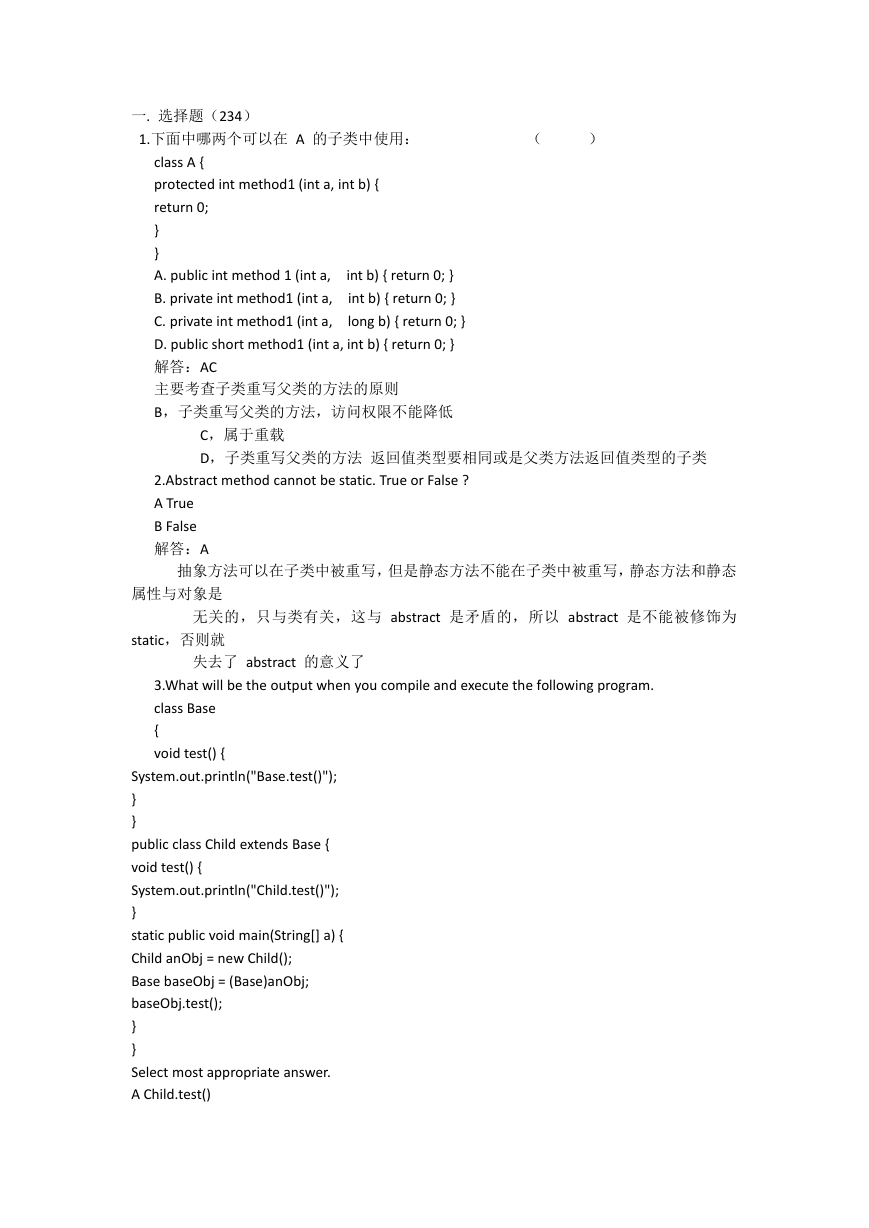

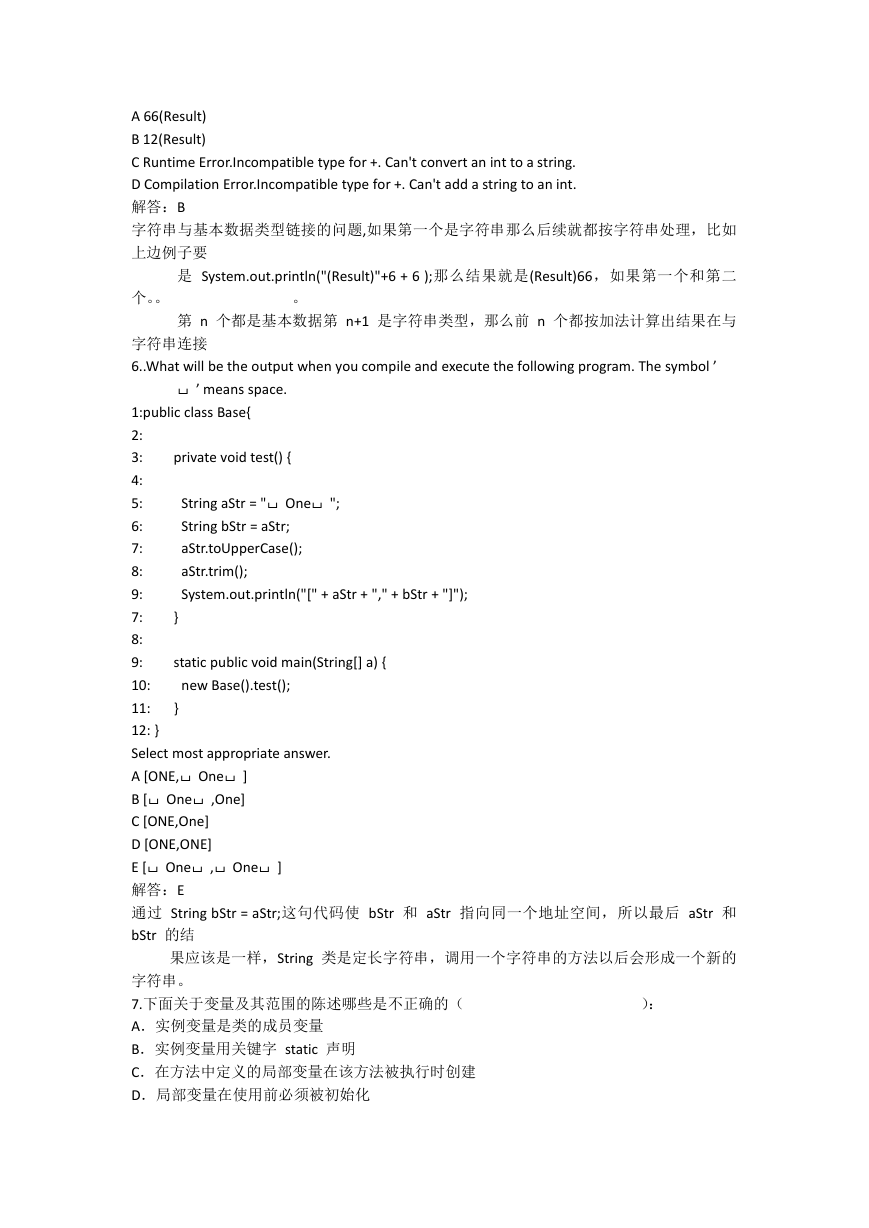
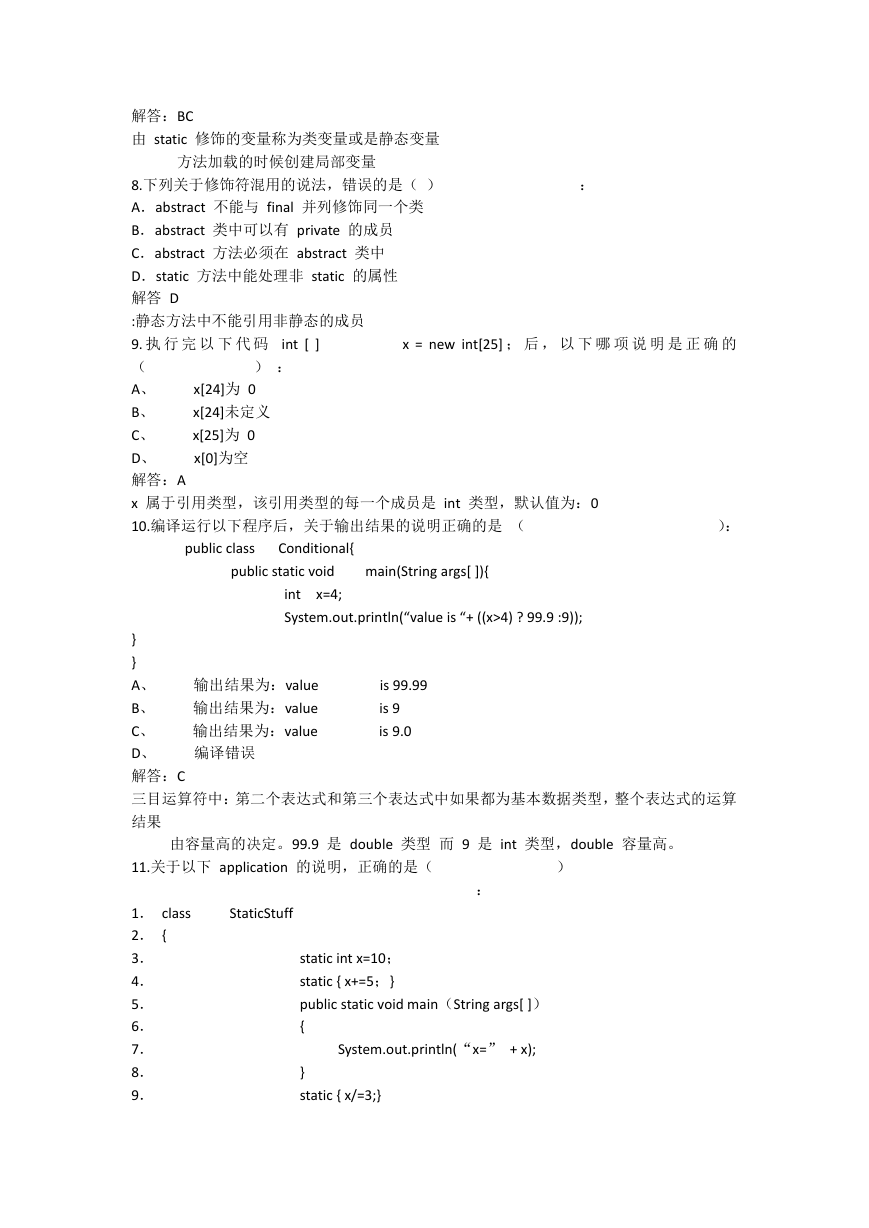
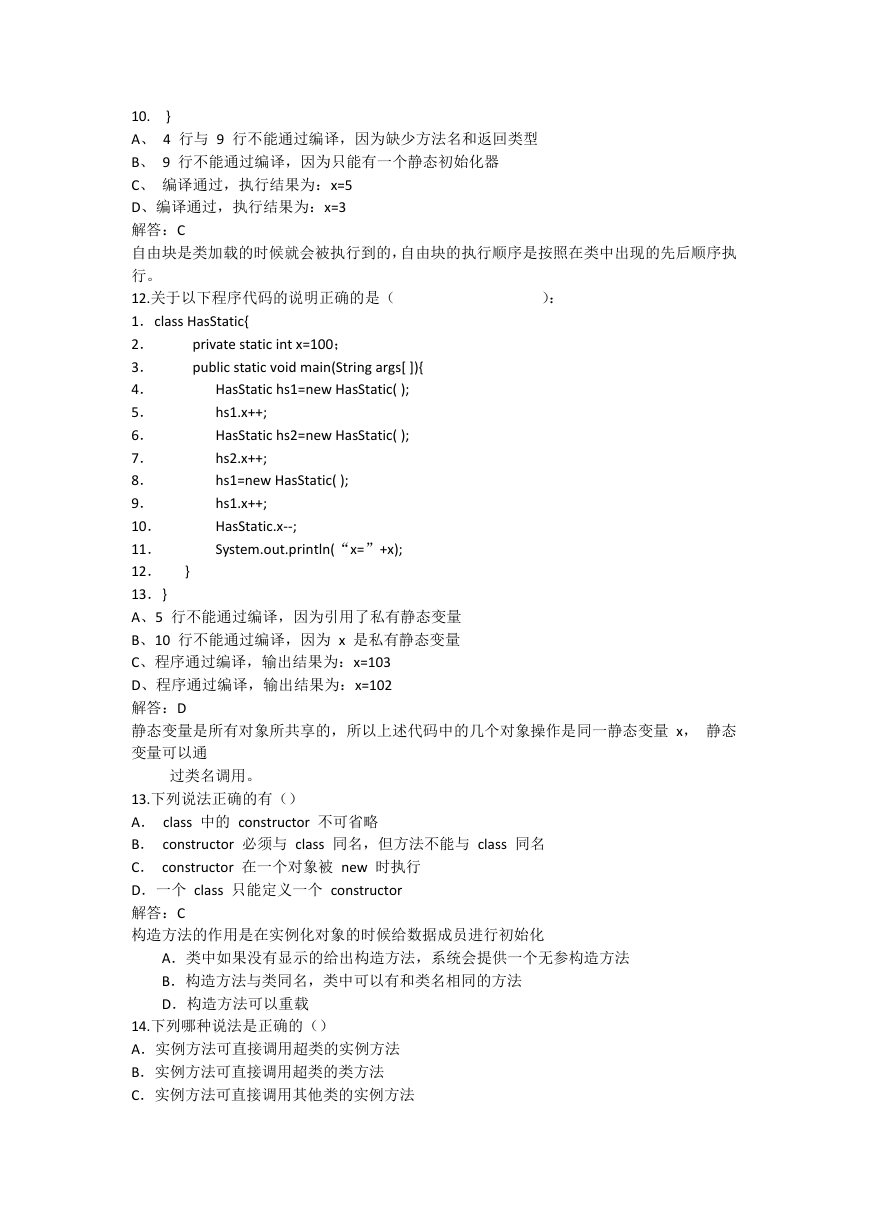
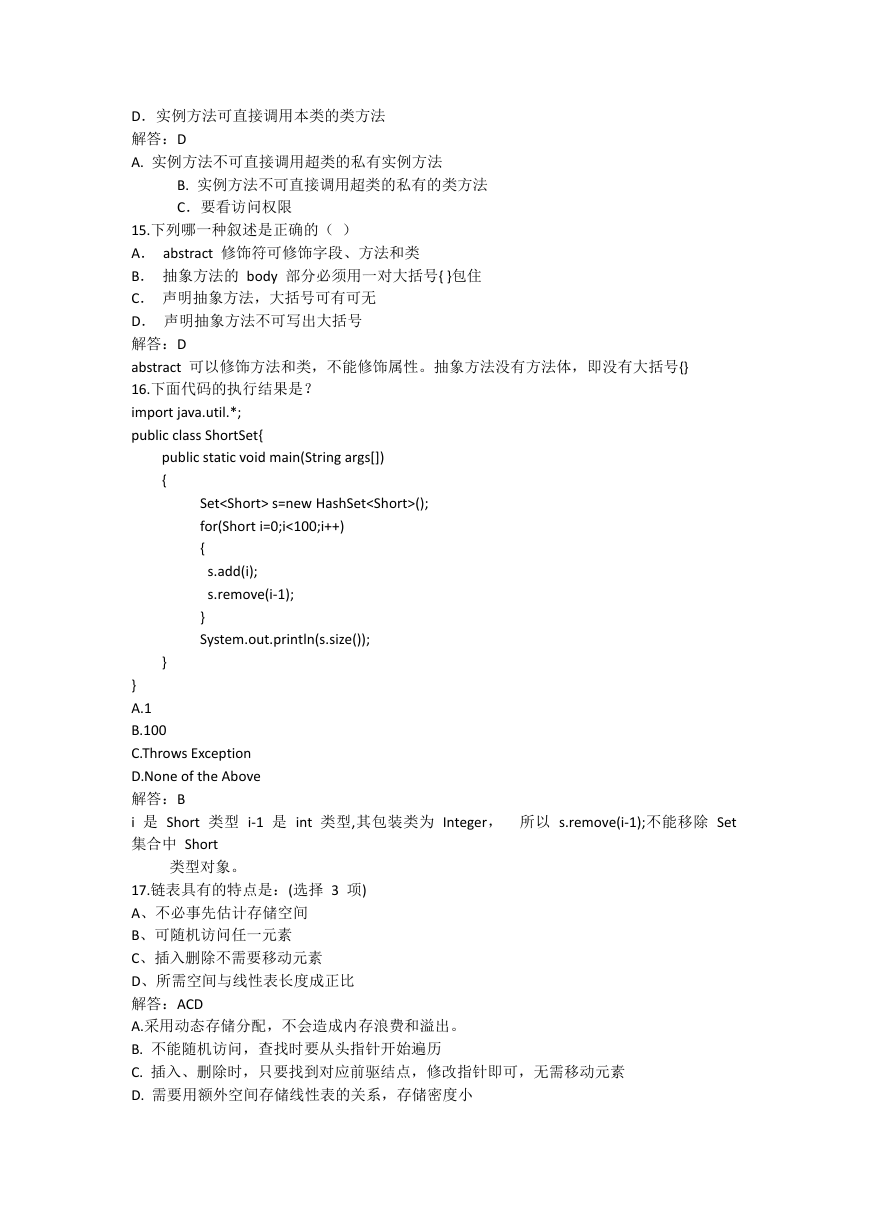
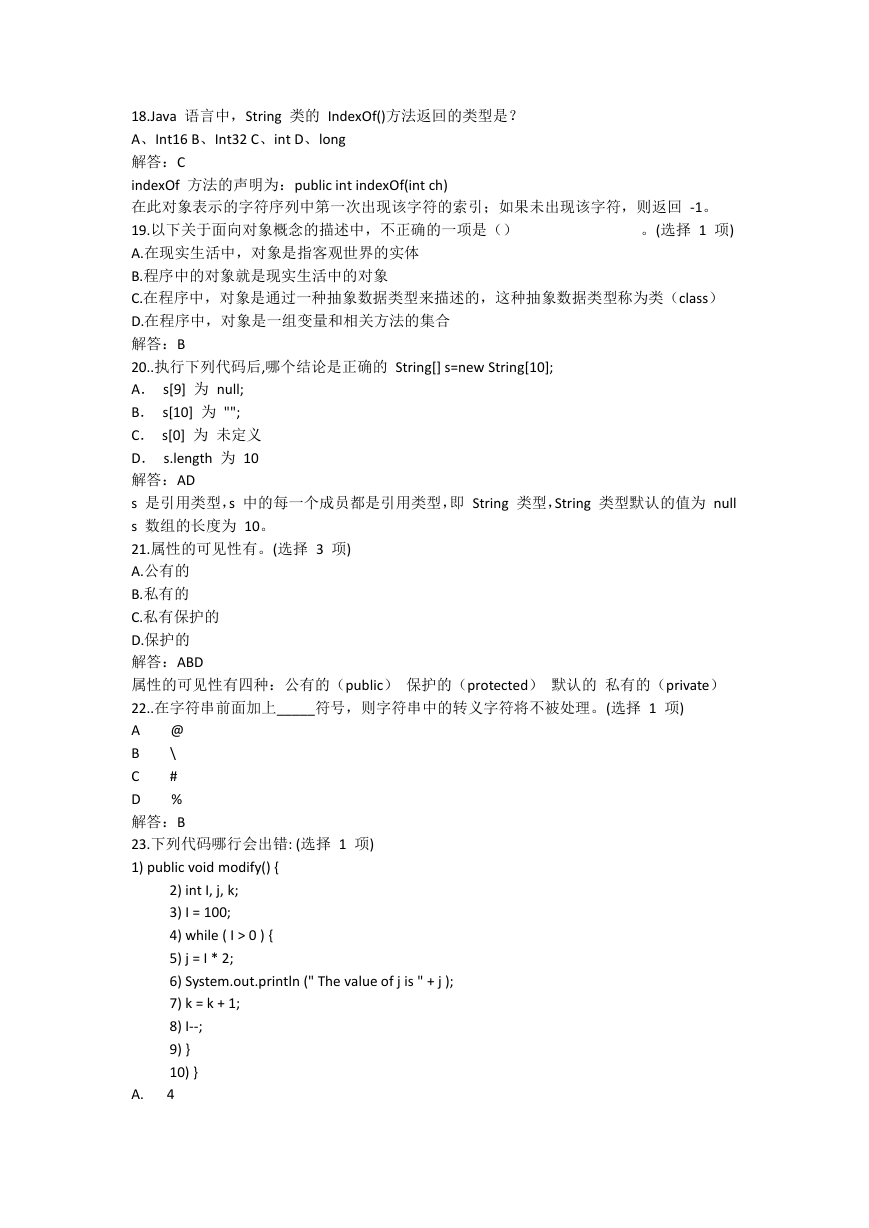









 2023年江西萍乡中考道德与法治真题及答案.doc
2023年江西萍乡中考道德与法治真题及答案.doc 2012年重庆南川中考生物真题及答案.doc
2012年重庆南川中考生物真题及答案.doc 2013年江西师范大学地理学综合及文艺理论基础考研真题.doc
2013年江西师范大学地理学综合及文艺理论基础考研真题.doc 2020年四川甘孜小升初语文真题及答案I卷.doc
2020年四川甘孜小升初语文真题及答案I卷.doc 2020年注册岩土工程师专业基础考试真题及答案.doc
2020年注册岩土工程师专业基础考试真题及答案.doc 2023-2024学年福建省厦门市九年级上学期数学月考试题及答案.doc
2023-2024学年福建省厦门市九年级上学期数学月考试题及答案.doc 2021-2022学年辽宁省沈阳市大东区九年级上学期语文期末试题及答案.doc
2021-2022学年辽宁省沈阳市大东区九年级上学期语文期末试题及答案.doc 2022-2023学年北京东城区初三第一学期物理期末试卷及答案.doc
2022-2023学年北京东城区初三第一学期物理期末试卷及答案.doc 2018上半年江西教师资格初中地理学科知识与教学能力真题及答案.doc
2018上半年江西教师资格初中地理学科知识与教学能力真题及答案.doc 2012年河北国家公务员申论考试真题及答案-省级.doc
2012年河北国家公务员申论考试真题及答案-省级.doc 2020-2021学年江苏省扬州市江都区邵樊片九年级上学期数学第一次质量检测试题及答案.doc
2020-2021学年江苏省扬州市江都区邵樊片九年级上学期数学第一次质量检测试题及答案.doc 2022下半年黑龙江教师资格证中学综合素质真题及答案.doc
2022下半年黑龙江教师资格证中学综合素质真题及答案.doc